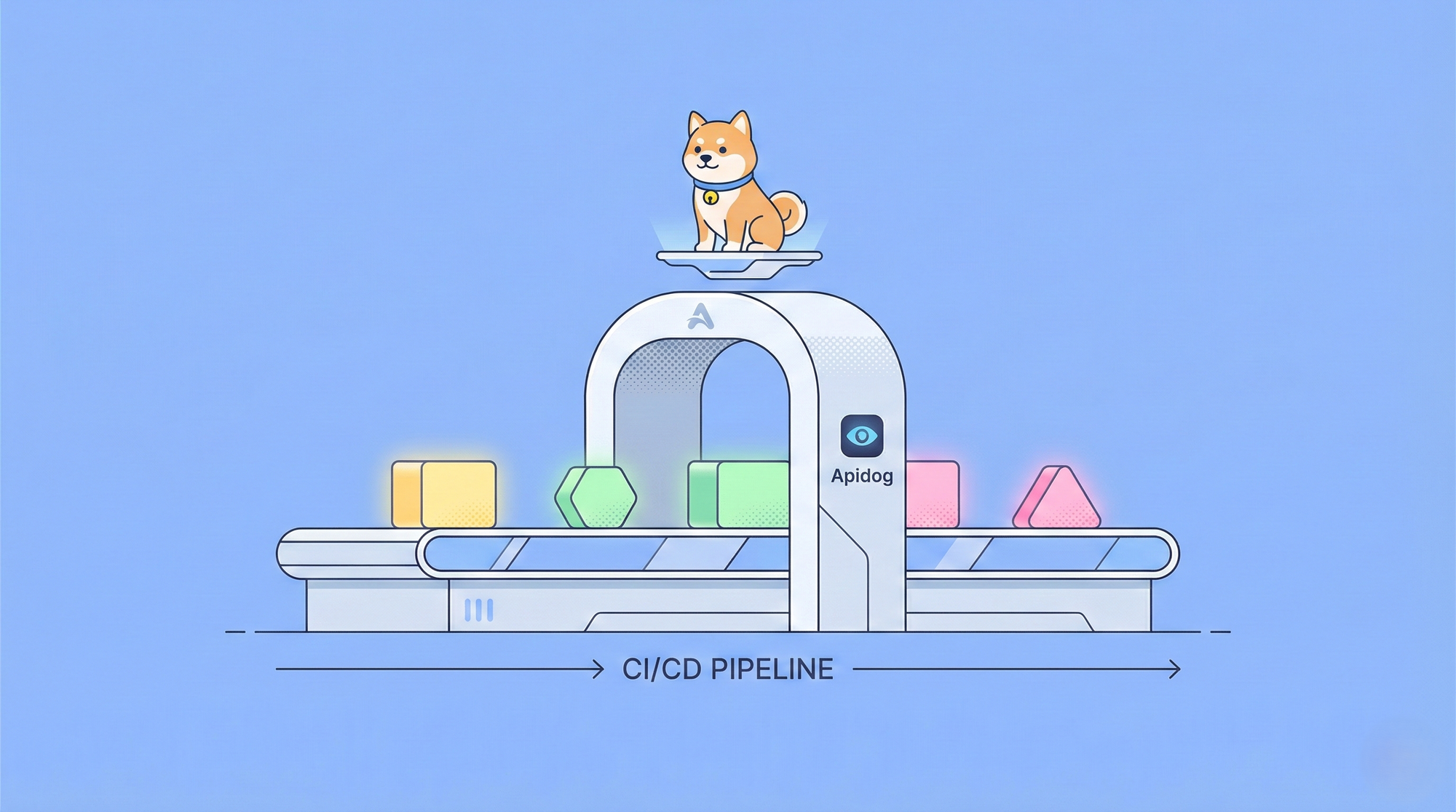Artificial intelligence is now easier than ever with the powerful combination of GPT-4.1 and Cline. Whether you're a developer, researcher, or tech enthusiast, integrating GPT-4.1 into your workflow can supercharge productivity, automate complex tasks, and open new creative possibilities. In this step-by-step guide, you'll learn exactly how to set up and use GPT-4.1 with Cline, from installation to advanced usage tips.
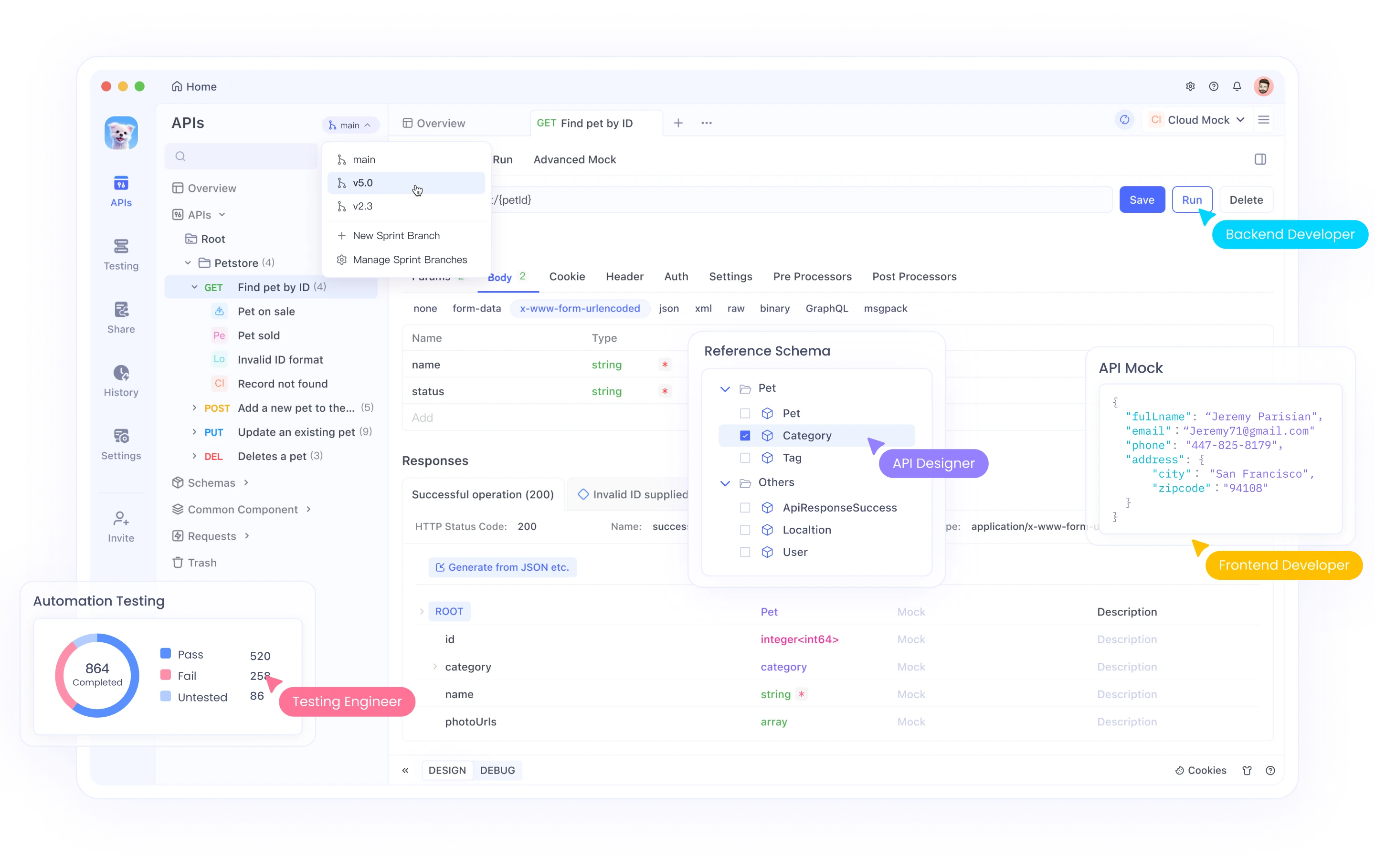
Whether you're building RESTful APIs or integrating third-party services, Apidog helps teams:
- Design and test APIs with ease
- Generate and share documentation instantly
- Collaborate with frontend/backend teams in real time
If you're using Cline and GPT-4.1 to understand backend logic, Apidog is the perfect complement to manage your API layers with speed and clarity.
Understanding Cline and GPT-4.1
What is Cline?
Cline is a terminal-based interface that brings AI capabilities directly to your command line. Developed to seamlessly integrate with developers' existing workflows, Cline eliminates the need to switch between applications when seeking AI assistance.
Unlike browser-based interfaces or standalone applications, Cline operates where many developers already spend most of their time—the terminal—making AI assistance feel like a natural extension of existing command-line tools.
The Power of GPT-4.1
GPT-4.1 represents a significant advancement in OpenAI's language model capabilities, with two standout features highlighted in Kahn's announcement:

- Expanded Context Window: GPT-4.1 supports a 1 million token context window, approximately equivalent to 750,000 words or 2,000 pages of text. This allows the model to process and maintain context across extremely large documents, codebases, or conversations.
- Enhanced Coding Capabilities: With a 21.4% improvement on SWE-bench Verified metrics over previous versions, GPT-4.1 demonstrates substantially improved software engineering abilities, offering more accurate and helpful coding assistance.
Getting Started with Cline
Cline is a Visual Studio Code (VS Code) extension that brings AI-powered coding assistance directly to your editor. Follow these steps to install and start using Cline:
Installation
Recommended: Install from the VS Code Marketplace
- Open Visual Studio Code.
- Go to the Extensions view (
Ctrl+Shift+X). - Search for "Cline".
- Click "Install" next to the Cline extension by saoudrizwan.
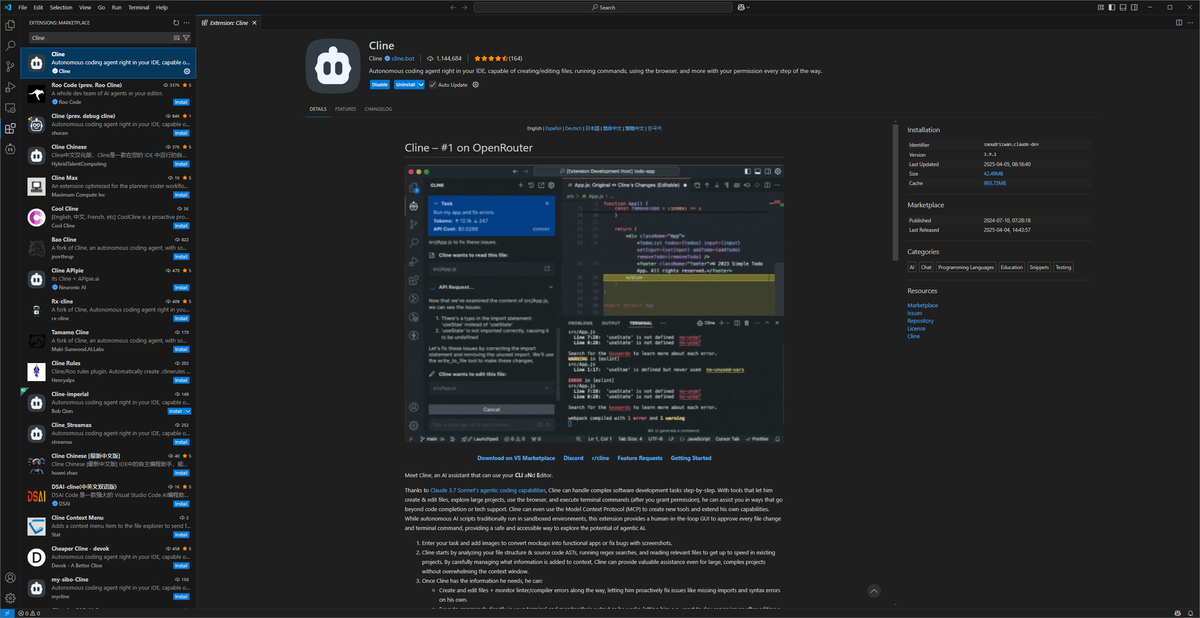
Alternative: Open VSX Registry
- For VS Code-compatible editors (like VSCodium), search for "Cline" in the Open VSX Registry and install it.
Setup and Authentication
Open Cline in VS Code:
- Click the Cline icon in the Activity Bar, or use the command palette (
Ctrl+Shift+P) and type "Cline: Open In New Tab".
Create and Sign In to Your Cline Account:
- Click the "Sign In" button in the Cline extension.
- You will be directed to app.cline.bot to create your account.
- No credit card is required to start; you receive free credits upon signup.
Accessing AI Models (including GPT-4.1):
- Once signed in, you can use Cline’s chat window to interact with advanced AI models, including GPT-4.1, Claude 3.5, etc.

- You do not need to provide your own OpenAI API key; access is managed through your Cline account.
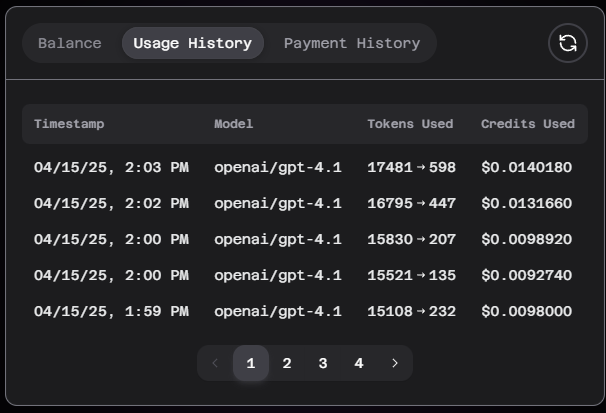
Leveraging GPT-4.1's 1M Token Context Window
The expanded context window of GPT-4.1 enables several powerful use cases through Cline:
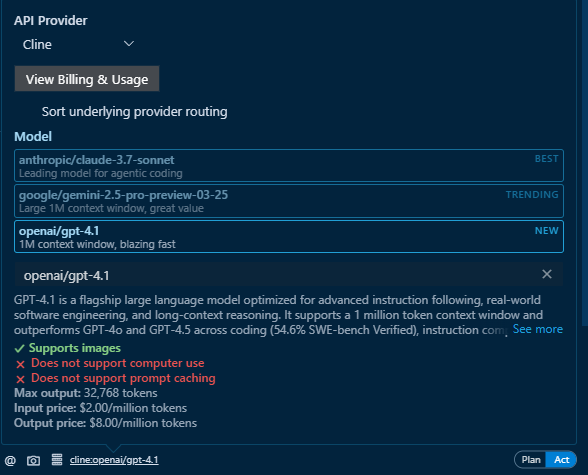
Working with Entire Codebases
# Conceptual example of analyzing a project
cline analyze ./my-project --model gpt-4.1
This capability allows you to get insights about large projects without artificially breaking them into smaller chunks, maintaining full context across thousands of files.
Processing Long Documents
# Conceptual example of summarizing a large document
cat long-document.md | cline summarize --model gpt-4.1
The million-token context window enables processing of entire books, research papers, or documentation sets in a single operation.
Extended Conversations
The expanded context enables maintaining the full history of complex problem-solving sessions:
# Conceptual example of a conversation session
cline chat start "Let's debug the authentication system"
# Many exchanges later...
cline chat continue "Now let's implement the solution we discussed earlier"
Enhanced Software Engineering Capabilities
GPT-4.1's improved coding abilities manifest in several practical applications through Cline:
Code Generation
# Conceptual example of generating code
cline code "Create a React component that displays a sortable table with pagination"
The model's enhanced understanding of software engineering principles results in more accurate, efficient, and maintainable code generation.
Code Analysis and Explanation
# Conceptual example of analyzing code
cat complex_algorithm.py | cline explain
GPT-4.1 can provide more insightful explanations of complex code, breaking down intricate algorithms or patterns into understandable components.
Debugging Assistance
# Conceptual example of debugging help
cat error_log.txt | cline debug
The improved reasoning capabilities help identify potential causes and solutions for bugs more accurately than previous models.
Integrating Cline with Your Development Workflow
Terminal-based tools excel at integration with existing workflows. Here's how Cline likely fits into your development process:
Command Chaining and Pipes
Cline presumably works well with Unix pipes, allowing you to process the output of other commands:
# Conceptual pipeline example
git diff HEAD~3 | cline explain "What changed in the last 3 commits?"
This capability enables seamless integration with other development tools like git, grep, or find.
Custom Shell Functions
Create personalized commands that combine Cline with other tools:
# Example shell function
function explain_file() {
cat "$1" | cline explain --model gpt-4.1
}
These custom functions can significantly streamline repetitive tasks that benefit from AI assistance.
Project-Specific Configurations
For teams working on shared codebases, Cline might support project-specific settings:
# Conceptual example of setting project preferences
cline config set default-model gpt-4.1
cline config set style concise
This ensures consistency in how AI assistance is utilized across team members.
Practical Applications
For Software Development
Code Review Assistance:
git show | cline review
Get AI-powered suggestions for improving code quality, identifying potential bugs, or enhancing performance.
Documentation Generation:
cat src/api/user.js | cline document
Automatically generate clear, comprehensive documentation for functions, classes, or APIs.
Test Case Generation:
cat src/calculator.js | cline generate-tests
Create comprehensive test suites based on existing code implementation.
For System Administration
Log Analysis:
cat /var/log/system.log | cline analyze "Find unusual patterns"
Quickly identify anomalies or security concerns in system logs.
Configuration Assistance:
cline help "Configure Nginx as a reverse proxy for Node.js"
Get specific guidance for complex system configurations.
Shell Script Generation:
cline script "Create a backup script that archives logs older than 30 days"
Generate utility scripts for common administrative tasks.
For Data Analysis
Query Generation:
cline sql "Find all users who signed up last month but haven't made a purchase"
Convert natural language requests into SQL, MongoDB, or other query languages.
Data Transformation:
cat messy_data.csv | cline clean > cleaned_data.csv
Process and normalize data directly in your data pipeline.
Best Practices for Using GPT-4.1 with Cline
Effective Prompting
Be Specific: Clearly communicate your requirements and expectations.
# Less effective:
cline help "Fix my code"
# More effective:
cline help "Fix the memory leak in this C++ function that processes large arrays"
Provide Context: Include relevant background information when needed.
cline ask "How to optimize this query for PostgreSQL 14 running on AWS RDS r5.large instances"
Specify Output Format: Indicate your preferred response structure.
cline explain --format markdown "How does OAuth 2.0 authorization flow work?"
Managing Resources
Monitor API Usage: Keep track of token consumption, especially when using the extended context window.
cline usage stats --period last-month
Use Appropriate Context Size: Only use the full context window when necessary.
cline analyze --context-size medium ./small-project
Cache Common Queries: Save responses for frequently asked questions.
cline ask "How to implement a binary search tree?" --save bst_implementation
Limitations and Considerations
While powerful, using GPT-4.1 with Cline comes with important considerations:
- API Costs: The extended context window and advanced capabilities may incur higher API costs than previous models.
- Verification Requirement: Always verify generated code, especially for security-critical applications.
- Privacy Considerations: Be mindful of sensitive information sent to external APIs through the terminal.
- Network Dependency: Unlike traditional terminal tools, Cline requires internet connectivity to access OpenAI's API.
Future Directions
As Cline and GPT-4.1 integration matures, we might expect:
- Specialized Commands: Purpose-built commands optimized for specific developer tasks.
- Local Processing Options: Potential for running smaller models locally for privacy-sensitive tasks.
- Enhanced Collaboration Features: Team-oriented capabilities for sharing AI-assisted solutions.
- Custom Model Fine-tuning: Organization-specific customization of model behavior.
Conclusion
The integration of GPT-4.1 with Cline represents a significant advancement in bringing AI capabilities directly into developers' terminal workflows. By leveraging GPT-4.1's expanded context window and enhanced coding capabilities, Cline transforms the terminal into an intelligent assistant capable of understanding complex codebases, generating sophisticated solutions, and providing context-aware guidance.
While specific commands and features will continue to evolve as official documentation emerges, the potential impact on developer productivity is clear. By eliminating context switching and providing AI assistance where developers already work, Cline with GPT-4.1 streamlines the development process and makes powerful AI capabilities feel like a natural extension of the terminal environment.

